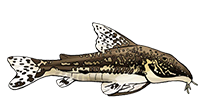Comparative anatomy of the cheek muscles within the Centromochlinae subfamily (Ostariophysi, Siluriformes, Auchenipteridae)
Luisa Maria Sarmento-Soares 1 *, Marcovan Porto 2
1Setor de Ictiologia, Departamento de Vertebrados, Museu Nacional, Niterói, RJ, Brasil
2Laboratório de Anatomia Comparada, Centro de Primatologia do Estado do Rio de Janeiro-CPRJ, ParaÃso, Guapimirim, RJ, Brasil
email: Luisa Maria Sarmento-Soares ([email protected])
*Correspondence to Luisa Maria Sarmento-Soares, Setor de Ictiologia, Departamento de Vertebrados, Museu Nacional, Quinta da Boa Vista, São Cristóvão, 20940-040, Rio de Janeiro, RJ, Brasil
Keywords
Glanidium . Tatia . Centromochlus . catfish . morphology . muscle
Abstract
Glanidium melanopterum Miranda Ribeiro, a typical representative of the subfamily Centromochlinae (Siluriformes: Auchenipteridae), is herein described myologically and compared to other representative species within the group, Glanidium ribeiroi, G. leopardum, Tatia neivai, T. intermedia, T. creutzbergi, Centromochlus heckelii, and C. existimatus. The structure of seven pairs of striated cephalic muscles was compared anatomically: adductor mandibulae, levator arcus palatini, dilatator operculi, adductor arcus palatini, extensor tentaculi, retractor tentaculi, and levator operculi. We observed broad adductor mandibulae muscles in both Glanidium and Tatia, catfishes with depressed heads and smaller eyes. Similarities between muscles were observed: the presence of a large aponeurotic insertion for the levator arcus palatini muscle; an adductor arcus palatini muscle whose origin spread over the orbitosphenoid, pterosphenoid, and parasphenoid; and the extensor tentaculi muscle broadly attached to the autopalatine. There is no retractor tentaculi muscle in either the Glanidium or Tatia species. On the other hand, in Centromochlus, with forms having large eyes and the tallest head, the adductor mandibulae muscles are slim; there is a thin aponeurotic or muscular insertion for the levator arcus palatini muscle; the adductor arcus palatini muscle originates from a single osseous process, forming a keel on the parasphenoid; the extensor tentaculi muscle is loosely attached to the autopalatine, permitting exclusive rotating and sliding movements between this bone and the maxillary. The retractor tentaculi muscle is connected to the maxilla through a single tendon, so that both extensor and retractor tentaculi muscles contribute to a wide array of movements of the maxillary barbels. A discussion on the differences in autopalatine-maxillary movements among the analyzed groups is given. J. Morphol. © 2005 Wiley-Liss, Inc.
Centromochlinae cheek muscles
- Shane
- Expert
- Posts: 4646
- Joined: 30 Dec 2002, 22:12
- My articles: 69
- My images: 162
- My catfish: 75
- My cats species list: 4 (i:0, k:0)
- My aquaria list: 5 (i:5)
- Spotted: 99
- Location 1: Tysons
- Location 2: Virginia
- Contact:
Centromochlinae cheek muscles
"My journey is at an end and the tale is told. The reader who has followed so faithfully and so far, they have the right to ask, what do I bring back? It can be summed up in three words. Concentrate upon Uganda."
Winston Churchill, My African Journey
Winston Churchill, My African Journey




